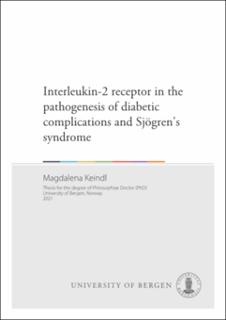| dc.contributor.author | Keindl, Magdalena | |
| dc.date.accessioned | 2021-11-26T12:45:07Z | |
| dc.date.available | 2021-11-26T12:45:07Z | |
| dc.date.issued | 2021-12-14 | |
| dc.date.submitted | 2021-11-22T14:28:11.572Z | |
| dc.identifier | container/26/7b/76/38/267b7638-150e-4796-b94e-5df8f5f49fce | |
| dc.identifier.isbn | 9788230845080 | |
| dc.identifier.isbn | 9788230864517 | |
| dc.identifier.uri | https://hdl.handle.net/11250/2831678 | |
| dc.description.abstract | The cytokine interleukin-2 (IL-2) acts as a double-edged sword by promoting both immunity and immune tolerance. Regulatory T cells (Tregs) are responsible for maintaining self-tolerance and constitutively express the high affinity form of the IL-2 receptor (IL-2R). IL-2/IL-2R signalling is crucial for the survival of Tregs and disruptions can promote the development of autoimmune diseases, such as type 1 diabetes (T1D) and Sjögren’s syndrome (SS). Elevated plasma levels of the soluble form of IL-2R (sIL-2R) have been associated with different autoimmune diseases including T1D and SS. Autoimmune diseases are chronic and frequently lead to complications of various forms. In people with diabetes, the risk of developing complications is modified by numerous factors including duration of disease and level of glycaemic control and can affect vital organs including eyes, kidneys and blood vessels leading to retinopathy, nephropathy and cardiovascular disease (CVD). The role of immune factors and its complex architecture in diabetic complications has not been entirely established. The overall aim of this thesis was therefore to identify and study immune markers associated with complications in diabetes. Furthermore, we aimed to functionally investigate IL-2/IL-2R signalling in Tregs from patients with different severities of SS.
In our first study (paper I) we found that elevated levels of sIL-2R associated with the presence of vascular complications in patients with long-term T1D. Furthermore, we identified single nucleotide polymorphisms (SNP) in the IL2RA gene to be associated with sIL-2R. Finally, we observed a shift from naïve to effector T cells in patients with vascular complications compared with those without, indicating a breakage of immune tolerance, thus allowing an increase in pro-inflammatory T cells. We concluded that IL2RA SNPs may not only affect susceptibility to T1D, but also promote the development of vascular complications possibly by regulating sIL-2R plasma levels and lowering T cell responsiveness.
In paper II, we expanded our investigations on the link between sIL-2R and diabetic complications and included patients with different subtypes of diabetes such as type 2 diabetes (T2D). T2D is traditionally considered a non-autoimmune form of diabetes, however there is increasing evidence on immune-related factors involved in the pathogenesis of insulin resistance and T2D. Interestingly, we found that increased plasma sIL-2R was consistently associated with vascular complications, irrespective of the diabetes subtype, suggesting that high sIL-2R can be indicative of disease severity. This notion was further supported by our finding that insulin-dependent patients with T2D had significantly elevated sIL-2R compared with those without insulin treatment. Furthermore, we identified SNPs in the IL2RA gene to be associated with sIL-2R and a vascular complication phenotype in individuals with T2D. Together, these results support a role for sIL-2R and its association with IL2RA SNPs and diabetic complications, not only in T1D, but in other types of diabetes as well.
In our third project on SS (paper III), we investigated if IL-2/IL-2R signalling could be compromised in patients with elevated plasma levels of sIL-2R. For this we studied patients with SS and found that particularly patients with a pathologically low salivary flow exhibited highest levels of sIL-2R, which was also associated with seropositivity. Functional studies on Tregs revealed that patients with SS had a reduced IL-2/IL-2R signalling capacity indicating an impaired suppressive activity in those cells. Our data indicated that Tregs have a weakened immunosuppressive function in patients with SS, which could mediate an aggressive lymphocyte infiltration into salivary glands. This in turn induces sicca symptoms, which are associated with higher plasma sIL-2R.
Taken together, our findings highlight an association of elevated sIL-2R with disease severity in the autoimmune diseases T1D and SS reflected by the presence of severe vascular complications and pathologic sicca symptoms, respectively. Furthermore, increased sIL-2R levels are also associated with insulin-treated T2D and with vascular complications in general. We believe that circulating sIL-2R can potentially be used as an indicator of diabetes severity and assist in disease monitoring and treatment of complications in autoimmune diseases including diabetes. | en_US |
| dc.language.iso | eng | en_US |
| dc.publisher | The University of Bergen | en_US |
| dc.relation.haspart | Paper I: Keindl M, Fedotkina O, du Plessis E, Jain R, Bergum B, Jensen TM, Laustrup Moller C, Falhammar H, Nystrom T, Catrina SB, Jorneskog G, Groop L, Eliasson M, Eliasson B, Brismar K, Nilsson PM, Berg TJ, Appel S, Lyssenko V. Increased Plasma Soluble Interleukin-2 Receptor Alpha levels in Patients with Long-term Type 1 Diabetes with Vascular Complications associated with IL2RA and PTPN2 Gene Polymorphisms. Front Endocrinol. 2020;11:575469. The article is available at: <a href="https://hdl.handle.net/11250/2734199" target="blank">https://hdl.handle.net/11250/2734199</a> | en_US |
| dc.relation.haspart | Paper II: Keindl M, Fedotkina O, Cherviakova L, Khalimon N, Svietleisha T, Buldenko T, Nilsson PM, Appel S, Lyssenko V. Soluble IL-2 Receptor Alpha as a Biomarker of Diabetes Severity and Vascular Complications. The article is not available in BORA. | en_US |
| dc.relation.haspart | Paper III: Keindl M, Davies R, Bergum B, Brun JG, Hammenfors D, Jonsson R, Lyssenko V, Appel S. Impaired activation of STAT5 upon IL-2 stimulation in Tregs and elevated sIL-2R in Sjogren’s syndrome. The article is not available in BORA. | en_US |
| dc.rights | Attribution-NoDerivs (CC BY-ND). This item's rights statement or license does not apply to the included articles in the thesis. | |
| dc.rights.uri | https://creativecommons.org/licenses/by-nd/4.0/ | |
| dc.title | Interleukin-2 receptor in the pathogenesis of diabetic complications and Sjögren's syndrome | en_US |
| dc.type | Doctoral thesis | en_US |
| dc.date.updated | 2021-11-22T14:28:11.572Z | |
| dc.rights.holder | Copyright the Author. | en_US |
| dc.contributor.orcid | https://orcid.org/0000-0002-7163-0179 | |
| dc.description.degree | Doktorgradsavhandling | |
| fs.unitcode | 13-25-0 | |

